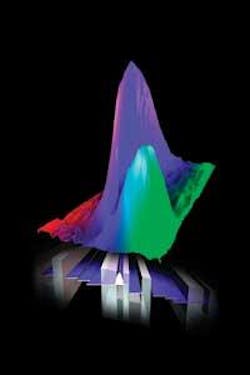The understanding of some of the most fundamental, and heretofore inaccessible, aspects of optical dynamics looks set to leap forward with the first-ever direct measurement of the phase in a medium with optical gain.
The work was published by Josef Kröll of the Vienna Institute of Technology and colleagues at the University of Paris and the Ecole Normale Superieure (Paris, France), and the Alcatel-Thales III-V Lab (Palaiseau, France).
Because of the extremely fast oscillations of the phase of laser light (just a few femtoseconds at visible wavelengths), phase measurements have been limited to the relative picture provided by interferometry. But the proliferation of terahertz lasers presents a unique opportunity to look at dynamics on a markedly reduced timescale.
For their experiments,Kröll and colleagues used terahertz quantum-cascade (QC) lasers-semiconductor sandwiches in which carriers trickle down a number of quantum mechanical levels, spitting out photons along the way.1 The researchers used a separate, pulsed 2.9 THz probe wave injected through this semiconductor gain medium while the QC laser is operating. At the other side, this time-domain signal shows modulations that, upon Fourier transformation, yield an absorption spectrum and a direct picture of the phase of the pulse (see figure). The method provides a unique window into the spectrally broad loss, the development of gain, and the amplification of a pulse as it builds up in the laser cavity.
At zero bias, the gain medium absorbs a number of frequencies. As the bias is ramped up, gain can be discerned by the distortions of the probe pulse. Above the lasing threshold of the QC laser, the modulations change again, showing how stimulated emission builds up. Successive passes of the gain medium show amplification, with a broadband response early that develops at later times to a narrowband emission at the lasing frequency. The results even show gain clamping at saturation.
As a first demonstration, the method is already paying dividends; one of the first measurements that the researchers undertook revealed a surprising picture of longitudinal spatial hole burning in the QC lasers.2
Potential studies
The approach opens up a huge range of fundamental studies on the dynamics of lasing, first of all on the intimate details of QC laser operation. One outstanding question about them concerns the dominant mechanisms that govern the transport of electrons through the injector region into the upper lasing state, and whether the transport is coherent or incoherent-a question that the new approach is well poised to answer.
Vienna’s Karl Unterrainer, senior author on the study, points out the flexibility of the approach. “The method can be extended to all lasers regardless of the emitting wavelength. In the extreme limit, even visible lasers could be studied if the attosecond resolution technique is employed,” he says. “And since we have control over the phase, quantum optical phenomena can be studied and eventually applied to optical transitions in semiconductor heterostructures. Control over the phase is the link between classical optoelectronics and quantum optics.”
As demonstrated, the probe pulses were quite weak so as not to perturb the operation of the QC laser. But even more interesting laser physics may be behind stronger terahertz pulses. For now, the group has gone on to apply the technique to mid-infrared QC lasers of various architectures, and is carrying out nonlinear measurements on saturation, gain recovery, and optical nonlinearity.
The gated detection of the probe pulse can divide up the various contributions to the observed average amplitude. “The method applied is blind to light that is either outside the time window or not phase-locked to injected probe pulse,” Unterrainer says. “So we separate out, for instance, spontaneous emission and amplified spontaneous emission. Therefore, it is a unique possibility to monitor the extent of coherence of optical transitions and the coherence of the carrier transport, if any is present.”
The most interesting result, says Unterrainer, is that the measurement of the phase of stimulated emission provides the first direct proof that the mechanism is amplification, instead of reduced absorption.
The power of this approach cannot be overstated, according to David Citrin of the Georgia Institute of Technology. “I thought that the neatest result was watching a pulse, bouncing in the laser cavity, build up intensity due to gain,” he says. But Citrin is most interested in the opportunities for future studies. “This type of experiment can provide insight in a direct way into the complex susceptibility in a quantum-cascade laser, both below and above threshold,” he notes. “Because it is a direct time-domain experiment, it can also probe how in time a pulse is amplified, how gain is depleted and recovers, and how future short-pulse lasers based on quantum-cascades may operate.”
REFERENCES
1. Kröll et. al., Nature 449, 698 (2007).
2. Kröll et. al., Appl. Phys. Lett. 91, 161108 (2007).
